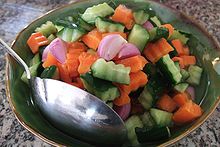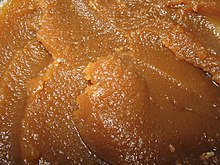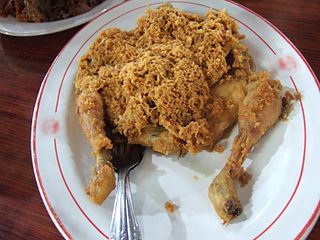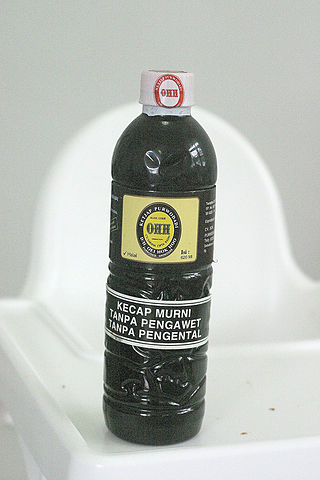Contents
- Sambals
- Sauces and pastes
- Relishes and pickles
- Garnishes, sprinkles and toppings
- Krupuk and kripik
- Spreads
- Gallery
- See also
- References
This is a list of Indonesian condiments .

This is a list of Indonesian condiments .












Indonesian cuisine is a collection of various regional culinary traditions that formed in the archipelagic nation of Indonesia. There are a wide variety of recipes and cuisines in part because Indonesia is composed of approximately 6,000 populated islands of the total 17,508 in the world's largest archipelago, with more than 1,300 ethnic groups.

Malay cuisine is the traditional food of the ethnic Malays of Southeast Asia, residing in modern-day Malaysia, Indonesia, Singapore, Brunei, Southern Thailand and the Philippines as well as Cocos Islands, Christmas Island, Sri Lanka and South Africa.

Fried rice is a dish of cooked rice that has been stir-fried in a wok or a frying pan and is usually mixed with other ingredients such as eggs, vegetables, seafood, or meat. It is often eaten by itself or as an accompaniment to another dish. Fried rice is a popular component of East Asian, Southeast Asian and certain South Asian cuisines, as well as a staple national dish of Indonesia. As a homemade dish, fried rice is typically made with ingredients left over from other dishes, leading to countless variations. Fried rice first developed during the Sui Dynasty in China.

Tempoyak, asam durian or pekasam is a Malay condiment made from fermented durian. It is usually consumed by the ethnic Malays in Maritime Southeast Asia, notably in Indonesia and Malaysia. Tempoyak is made by taking the flesh of durian and mixing it with some salt and kept in room temperature for three or five days for fermentation. Tempoyaks are usually made during the durian season, when the abundance of durian and excess production are made into fermented tempoyak.

Chinese Indonesian cuisine is characterized by the mixture of Chinese with local Indonesian style. Chinese Indonesians, mostly descendant of Han ethnic Hokkien and Hakka speakers, brought their legacy of Chinese cuisine, and modified some of the dishes with the addition of Indonesian ingredients, such as kecap manis, palm sugar, peanut sauce, chili, santan and local spices to form a hybrid Chinese-Indonesian cuisine. Some of the dishes and cakes share the same style as in Malaysia and Singapore, known as Nyonya cuisine by the Peranakan.

Nasi goreng is a Southeast Asian fried rice dish, usually cooked with pieces of meat and vegetables. One of Indonesia's national dishes, it is also eaten in Malay-speaking communities in countries such as Malaysia, Singapore and Brunei, and has gained popularity in Sri Lanka through migrations from the Indonesian Archipelago, in countries like Suriname via Indonesian immigrant communities, and in the Netherlands through its colonial ties with Indonesia. Nasi goreng is distinguished from other Asian fried rice preparations by its distinct smoky aroma, and caramelised yet savoury undertones of flavour. There is no single defined recipe for nasi goreng, and its composition and preparation varies greatly from household to household.

Lontong is an Indonesian dish made of compressed rice cake in the form of a cylinder wrapped inside a banana leaf, commonly found in Indonesia, Malaysia, and Singapore. Rice is rolled inside a banana leaf and boiled, then cut into small cakes as a staple food replacement for steamed rice. The texture is similar to that of ketupat, with the difference being that the ketupat container is made from woven janur fronds, while lontong uses banana leaf instead.

Javanese cuisine is the cuisine of Javanese people, a major ethnic group in Indonesia, more precisely the province of Central Java, Yogyakarta and East Java.

Sundanese cuisine is the cuisine of the Sundanese people of Western Java, and Banten, Indonesia. It is one of the most popular foods in Indonesia. Sundanese food is characterised by its freshness; the famous lalab eaten with sambal and also karedok demonstrate the Sundanese fondness for fresh raw vegetables. Unlike the rich and spicy taste, infused with coconut milk and curry of Minangkabau cuisine, the Sundanese cuisine displays the simple and clear taste; ranged from savoury salty, fresh sourness, mild sweetness, to hot and spicy.

Bumbu is the Indonesian word for a blend of spices and for pastes and it commonly appears in the names of spice mixtures, sauces and seasoning pastes. The official Indonesian language dictionary describes bumbu as "various types of herbs and plants that have a pleasant aroma and flavour — such as ginger, turmeric, galangal, nutmeg and pepper — used to enhance the flavour of the food."

Colo-colo is an acidic condiment commonly found in Maluku archipelago, Indonesia. It is believed to have originated in Ambon city, and accordingly is often described as Ambon's sambal. Colo-colo is similar to Manado's dabu-dabu, as they both use many chopped red chili peppers, bird's eye chili, shallots, red and green tomatoes, and a pinch of salt and sugar, mixed with fresh calamansi juice or locally known as lemon cui or jeruk kesturi. The main difference is that colo-colo recipe often includes additional ingredients, such as chopped lemon basil, kenari nut, and tahi minyak or ampas minyak, or caramelized rarobang. As a result, colo-colo is darker and more oily than dabu-dabu.

Ayam goreng is an Indonesian and Malaysian dish consisting of deep-fried chicken in oil. Ayam goreng literally means "fried chicken" in Malay, Indonesian and also in many Indonesian regional languages. Unlike other countries, Indonesian fried chicken usually uses turmeric and garlic as its main ingredients rather than flour.

Ikan goreng is a hot dish consisting of deep fried fish or other forms of seafood. Ikan goreng literally means "fried fish" in Indonesian and Malay languages.

Sambal is an Indonesian chili sauce or paste, typically made from a mixture of a variety of chilli peppers with secondary ingredients such as shrimp paste, garlic, ginger, shallot, scallion, palm sugar, and lime juice. Sambal is an Indonesian loanword of Javanese origin. It originated from the culinary traditions of Indonesia and is also an integral part of the cuisines of Singapore, Malaysia, Brunei, and Sri Lanka. It has also spread through overseas Indonesian populations to the Netherlands and Suriname.

Ikan bakar is an Indonesian and Malay dish, prepared with charcoal-grilled fish or other forms of seafood. Ikan bakar literally means "grilled fish" in Indonesian and Malay. Ikan bakar differs from other grilled fish dishes in that it often contains flavorings like bumbu, kecap manis, sambal, and is covered in a banana leaf and cooked on a charcoal fire.

Nasi gurih is an Indonesian steamed rice cooked in coconut milk and spices dish originally from Aceh, Indonesia.

Sweet soy sauce is a sweetened aromatic soy sauce, originating in Indonesia, which has a darker color, a viscous syrupy consistency, and a molasses-like flavor due to the generous addition of palm sugar or jaggery. Kecap manis is widely used with satay. It is similar to, though finer in flavor than, Chinese Tianmian sauce (tianmianjiang). It is by far the most popular type of soy sauce employed in Indonesian cuisine and accounts for an estimated 90 percent of the nation's total soy sauce production.

Bawang goreng is an Indonesian crispy fried shallots condiment, commonly deep-fried, a popular garnish to be sprinkled upon various dishes of Indonesian cuisine. It is quite similar to crisp fried onion.

Indonesian noodles are a significant aspect of Indonesian cuisine which is itself very diverse. Indonesian cuisine recognizes many types of noodles, with each region of the country often developing its own distinct recipes.